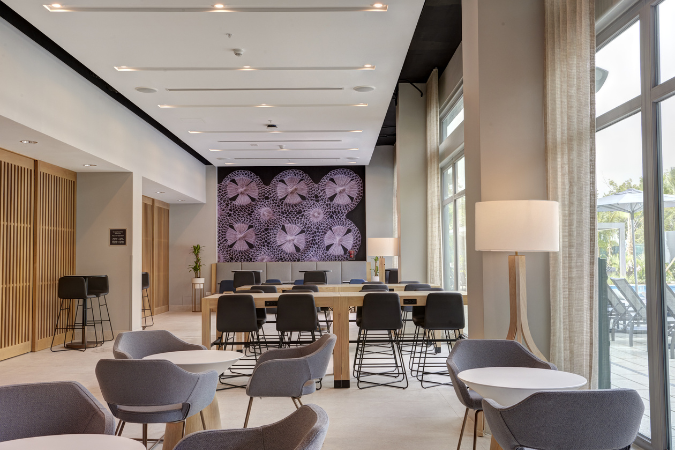9 Principles to Create Functional Hospitality Design
Written By AD&V®ABOUT THE AUTHOR | AD&V® is dedicated to advanced and energy-efficient sustainable architecture & interior design that enhances people’s experience of the world and improves their lives.
WHEN DESIGNING SPACES IN THE HOSPITALITY INDUSTRY, FUNCTIONALITY PLAYS A CRUCIAL ROLE IN ENSURING A POSITIVE AND MEMORABLE GUEST EXPERIENCE.
Applying the correct design principles, you can create a welcoming and functional hospitality environment that every guest will enjoy.
Here are some things to consider to create functional hospitality design that guests will love and keep coming back to:
1. UNDERSTAND YOUR GUESTS
The first principle in creating a functional hospitality design is understanding your guests’ needs. Research and analyze your target market, their preferences, and expectations.
Consider factors such as age, culture, and the purpose of their visit. This information will help you create a design that caters to their needs and preferences. It will also help you make informed decisions regarding layouts, amenities, and overall aesthetics of the space.
For example, if you are designing a hotel for business travelers, you must provide them with a comfortable workspace, high-speed internet, and ample storage space. Understanding your guests will help you create a space that meets their needs and exceeds their expectations.
2. MAKE IT ACCESSIBLE
To create genuinely functional hospitality spaces, it is essential to prioritize accessibility and inclusivity.
Incorporate inclusive design principles to ensure that guests of all abilities can navigate and enjoy spaces comfortably. For example, install ramps, design accessible bathrooms, and provide clear pathways throughout the property to accommodate guests with disabilities. Creating accessible spaces that effortlessly accommodate diverse needs will make all guests feel welcome.
3. EMBRACE FLEXIBILITY
Hospitality design needs to be flexible and adaptable to accommodate the changing needs of guests. For this reason, ensure that rooms can be easily reconfigured to accommodate different types of events and guests, such as business travelers, families, or solo travelers.
Invest in modular furniture that can be rearranged to create various seating options and functional spaces. Consider incorporating movable walls or partitions to quickly transform a space from a meeting room to a dining area or a lounge. Investing in adaptable furniture and layouts allows for a more pleasant and functional guest experience.
4. PRIORITIZE COMFORT
Comfort should be a top priority when designing any hospitality space. Guests should feel relaxed and at ease, whether staying overnight or just passing through.
Choose furniture that is comfortable, ergonomic, and durable. Opt for plush seating, natural and soft lighting, and high-quality bedding to create a cozy atmosphere. You should also consider the acoustics of your space to ensure that guests are not disturbed by noise from other areas.
Additionally, ensure that the space is well insulated and has adequate heating and cooling systems to maintain optimal room temperature. Prioritizing comfort will help you create a space that guests will love to spend time in.
5. DESIGN FOR SUSTAINABILITY
Designing for sustainability is now the norm rather than the exception. This is why functional hospitality design should also consider sustainability.
Incorporate eco-friendly materials, energy-efficient systems, and sustainable design principles into your design. Using renewable resources optimizes energy consumption while creating functional spaces with minimal environmental impact.
6. INTEGRATE TECHNOLOGY
Integrating technology into your hospitality design can significantly enhance the guest experience and streamline operations, especially now that we’re all constantly connected.
If hotels don’t have the functionality to support guests’ technological devices in their spaces, people are probably going to choose to stay elsewhere.
Consider incorporating smart devices, automation systems, and intuitive interfaces to control lighting, temperature, entertainment, and other aspects of the guest's stay. Embrace technology as a tool to enhance functionality and convenience.
7. PAY ATTENTION TO DETAIL
Details matter in hospitality design. Paying attention to the small things can elevate your space and make it stand out. Focus on elements such as lighting, artwork, and accessories to create a cohesive and well-thought-out design.
Include unique and eye-catching elements that create warm and inviting spaces. Paying attention to details will help you create a unique space that guests will remember.
8. CREATE A SENSE OF PLACE
A successful hospitality design should create a sense of place that reflects the local culture, community, and environment. Incorporate elements that showcase the region's history, traditions, and natural beauty.
For example, you can use locally sourced materials, artwork from local artists, or decorative elements inspired by the region's flora and fauna. By creating a sense of place, guests feel more connected to their surroundings and can have a more authentic experience.
9. BALANCE FORM & FUNCTION
It’s essential to balance form and function in your hospitality design. Ensure that your design is practical, easy to maintain, and caters to the needs of your guests.
Additionally, consider the flow and layout of the space, making sure it is simple for guests to find what they need. Balancing form and function will help you to create a space that is both beautiful and functional.
A SEAMLESS EXPERIENCE
While aesthetics are crucial to create a visually appealing space, functionality should not be compromised. Creating functional hospitality design requires a thorough understanding of guests, embracing flexibility, designing for sustainability, prioritizing comfort, paying attention to detail, integrating technology, creating a sense of place, and balancing form and function. By applying these nine principles, you can create a functional and welcoming hospitality design that looks great and provides a meaningful and seamless experience for your guests.
FURTHER READING: 6 WAYS NATURE INFLUENCES HOSPITALITY DESIGN & EXPERIENCE

